I've been trading cryptocurrencies for over eight years, from liquidation to achieving financial freedom, supporting my family through trading. From May 23, 2022, to August 25, 2025, in three years, starting with less than 700,000, I achieved a win rate of 778134.86%, making over 48 million.
Today I will share my trading strategies and insights with friends in the crypto world.
There is a saying, standing on the shoulders of giants saves ten years of effort.
For those who are lucky enough to see this and want to improve their trading skills, you must read more carefully and I suggest saving this!
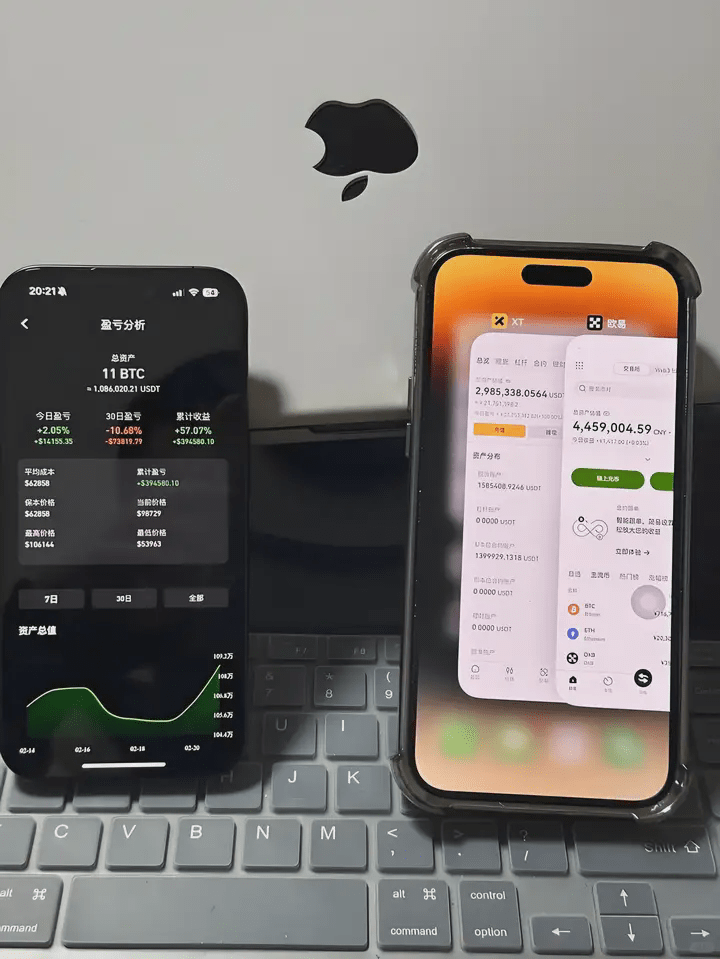
In addition to sharing solid technical skills, I strictly adhere to the following 7 ironclad rules:
1. Coin Accumulation Method: Suitable for both bull and bear markets. The coin accumulation method is the simplest yet the hardest strategy. You just need to buy one or several coins and hold them for more than half a year or a year without any operation. Theoretically, the minimum return can be tenfold. However, beginners often struggle to persist; when they see high returns or the coin price plummets, they want to switch or exit. So, this is actually the hardest.
2. Bear Market Dip Chasing Method: Only suitable for bull markets. A portion of spare cash, preferably no more than one-fifth of your funds. This strategy is suitable for coins valued between 20-100 dollars, as you won't be stuck for too long. For example, if you buy the first altcoin and it rises by 50% or more, you can switch to the next coin that has dropped sharply, and continue this cycle. If the first altcoin gets stuck, just wait; the bull market will definitely break you free. The premise is that the coin must not be too risky, and newcomers should be cautious.
3. Hourglass Car Switching Method: Suitable for bull markets. In a bull market, basically any coin you buy will rise, and funds flow like a giant hourglass, slowly seeping into each coin. Start with large coins like BTC, ETH, DASH, ETC, followed by mainstream coins like LTC, XMR, EOS, NEO, QTUM, and then onto coins that have not yet risen before moving on to various small coins taking turns to rise. If Bitcoin rises, you pick the next level of coins to start accumulating.
4. Pyramid Bottom Buying Method: Suitable for anticipated sharp declines. The bottom buying method: place orders to buy one-tenth of your position at 80%, 70%, 60%, and 50% of the coin price. This way, you can seize more opportunities during a sharp decline.
5. Moving Average Method: Understand some basic candlestick knowledge. Set indicator parameters MA5, MA10, MA20, MA30, MA60, and choose a daily line. If the current price is above MA5 and MA10, hold on firmly; if MA5 drops below MA10, sell the coin; if MA5 rises above MA10, buy and start building a position.
6. Aggressive Coin Accumulation Method: Suitable for long-term quality coins. Have some liquid funds, and when a certain coin is priced at 8 dollars, place an order to buy at 7 dollars. When the purchase is successful, place an order to sell at 8.8 dollars. The profit is used to accumulate coins, and the liquid funds are taken out to wait for the next opportunity. If there are three such opportunities in a month, you can accumulate a lot of coins. The formula is the purchase price equal to the current price times 90%, and the selling price equal to the current price times 110%.
7. Small Coin Aggressive Strategy: If you have 10,000 RMB, divide it into ten portions and buy ten different types of small coins, preferably priced under 3 RMB. After buying, don't worry about it. Don't sell until it has tripled to five times in value, even if it gets stuck, just hold it long-term. After a coin triples, take back the principal of 1,000 RMB and invest it in the next small coin. This way, the compound returns can be quite impressive.
The above 7 principles apply to both spot trading and contract trading.
The core technique of position management is to operate in batches, which means dividing the funds and gradually building positions, increasing or decreasing as needed. Batch operations can be completed in a short time or executed gradually over a longer period.
Understanding and mastering the above position management principles and methods, whether for spot trading or contract trading, will provide you with clear direction and strong support on your investment journey in the crypto world.
I want to share some of my trading insights, mainly about how I analyze on daily and weekly charts. It’s like piecing together a puzzle; I focus on finding obvious price fluctuations, key price levels, trends, price movements, and market signals.
I love using 'clean' charts.
A clean chart refers to a chart without indicators. This type of chart is the basis of my technical analysis. My regular readers know that I do not like to overlay indicators on charts and prefer simple candlestick charts. Less is more, which is also my trading philosophy.
How do I analyze clean charts?
First, I will narrow down the weekly chart to look at the long-term price trends from a larger perspective. This step allows me to know what has happened in the market and how these events will affect the current situation.
In the chart below, I have narrowed down the cycles to look at market changes from a longer-term perspective. I have marked the most obvious support and resistance levels. As prices fluctuate up and down, the roles of support and resistance often switch places.
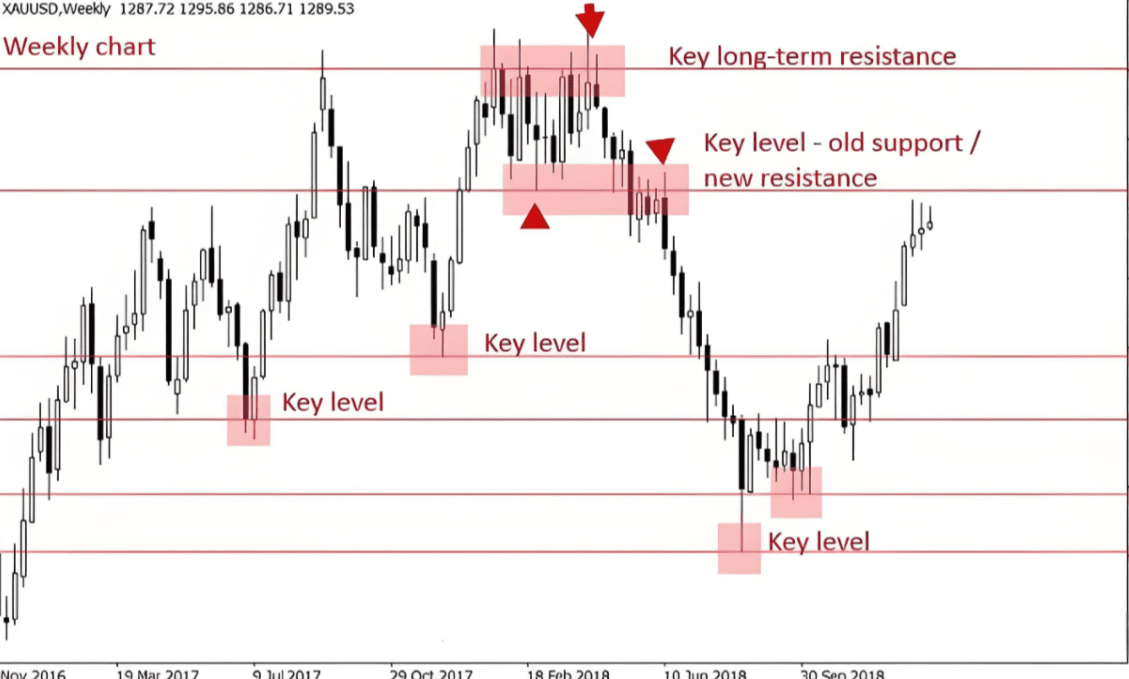
Golden Week Chart
Continuing to look at the daily chart below, I also narrowed down this chart to see the overall market changes in 2018, including trends and price fluctuations. I have also marked what I consider important price levels, consolidation areas, trend fluctuations, etc. These are the first things I pay attention to when analyzing a price chart.
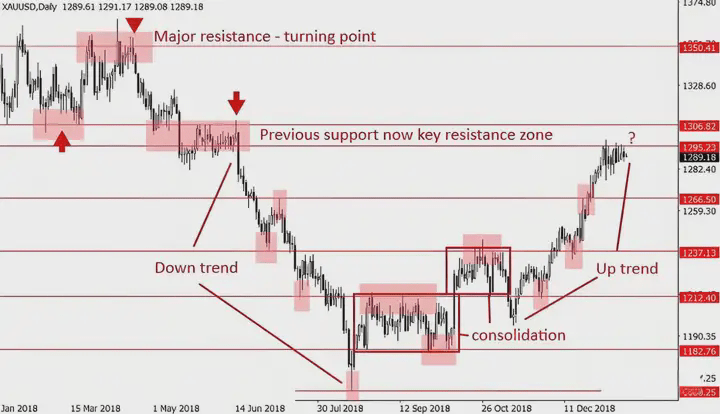
Gold Daily Chart
In the same chart as above, I made slight adjustments; in the chart below, I zoomed in a bit, but you can still see the same price levels.
First, note the bullish tailed bar on the left side of the chart, which is an important turning point for price fluctuations, after which the price begins to rise. Therefore, I draw a waterline at the low of the tailed bar; if the price later drops below this waterline, then it is another important related price level.
Then, pay attention as the price enters a consolidation period of about two months. After the breakout from consolidation, the price gradually rises and forms a bearish pin bar at the 1237.00 level, which is also the resistance level marked in the previous chart. This pin bar might be seen as a counter-trend pin bar, which I personally do not trade much. It appears at important price levels, and below it is the area near 1212.00, which was a previous breakout point. Some savvy traders may engage in short-term trading here.
Note that the previous range of 1212.00/1215.00 to 1205.00 is a strong support area because the price broke through here before. After an upward breakout, I will look for opportunities to go long.
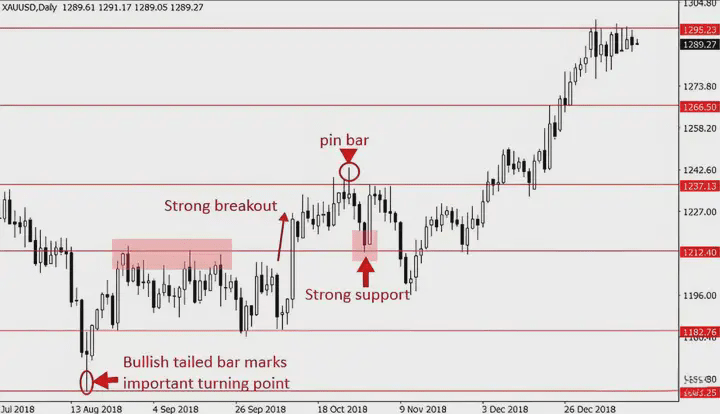
Gold Daily Chart
In the chart below, I pay attention to how previous price levels behave after market fluctuations. We can look for reversal opportunities at these price levels to trade with the trend.
Pay attention to the part I marked as 'watch for pullbacks' in the chart below, and see if the price will pull back in this area to trade with the trend, finding opportunities to go long. If the price pulls back in these areas, then we can find price movement signals nearby.
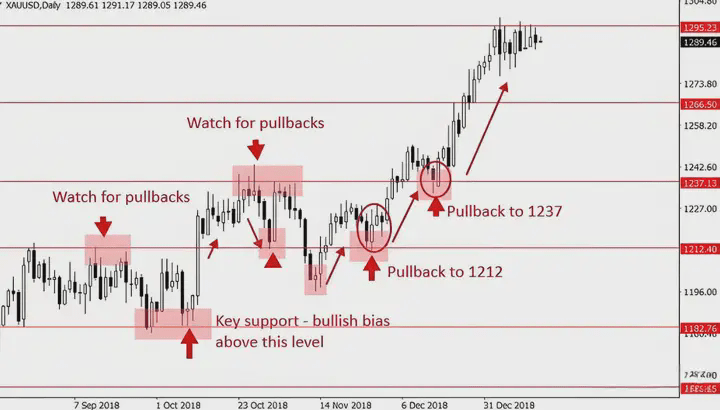
Gold Daily Chart
Finally, look at the chart below, which is the daily chart of gold. After the price pulled back near 1212.00 and 1237, some potential entry signals appeared.
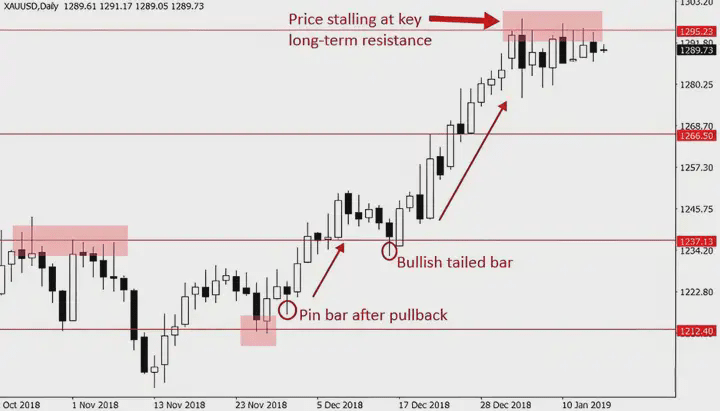
Conclusion
When analyzing the market, I often use a 'top-down' approach, which means starting with long-term price charts, narrowing down the charts to get an overall concept of fluctuations, and then gradually moving to smaller time frames to look at price changes more specifically. This perspective is like a bird's-eye view of the market, allowing for more meaningful analysis of recent changes based on an understanding of long-term variations.
Just like reading a book, to know the story on page 100, you need to understand what happened on pages 1-99. Trading is the same; we need to view the market as a whole and not understand it in isolation. Keeping in sync with market and price trends is one of the requirements for learning professional trading.
Finally, a warning for beginners! Beginners should never enter the crypto world without understanding anything; otherwise, it is easy to step on mines. Today I have organized a beginner's guide, so let’s take a look.
What is the crypto world?
Simply put, the crypto world is a large circle revolving around cryptocurrency, involving activities such as buying, selling, investing, mining, and project development. Crypto assets are based on blockchain technology, decentralized, and not controlled by central authorities. Doesn't that sound super cool?
Mainstream Digital Currencies
Bitcoin (BTC): The founder of cryptocurrencies, born in 2009, it is considered the 'gold standard' of the digital currency market, with significant value fluctuations that attract many investors.
Ethereum (ETH): Not just a payment system, but also a blockchain platform that can execute smart contracts, widely used in multiple industries, and is the cornerstone of decentralized applications (dApps).
Blockchain Technology
Blockchain is the underlying technology of cryptocurrencies, with core features of decentralization and immutability. It records each transaction as a block and links them into a chain, maintained by countless nodes, ensuring transparency and security in transactions, which is the foundation for the normal operation of the crypto world.
Choosing a trading platform
Centralized Exchanges (CEX): Like Binance, OKX, operated by centralized organizations, supporting various trading pairs, fast capital flow, and simple operations, but funds are stored on the platform, which carries certain risks.
Beginner's Tips
Understand the basics before entering the market; first grasp the concepts of blockchain and cryptocurrency to make informed decisions.
Avoid blindly following trends; deeply understand the projects, and do not invest in projects with unclear technology or team backgrounds.
Deep insight: The survival rule in the crypto world is not to pursue short-term profits, but to build a stable profit system. The effect of compound interest is like a snowball; the longer it rolls, the more powerful it becomes. Only by establishing a scientific position management and risk control mechanism can assets continue to appreciate amidst market fluctuations.
In the face of a rapidly changing market, we need to establish a dynamic observation system: when Bitcoin breaks through key resistance levels, when mainstream coins show divergence signals, and when the market sentiment index enters extreme zones, these are all important nodes worth paying attention to.
True winners in the crypto world can both profit in bull markets and preserve their strength in bear markets.
No matter how hard-working a fisherman is, he won't go out to sea in stormy weather, but will carefully protect his fishing boat. This season will eventually pass, and sunny days will come! Follow Awen, who will teach you how to fish and also how to fish sustainably; the door to the crypto world is always open. Only by going with the trend can you have a life in sync with the trend. Save this and keep it in mind!




